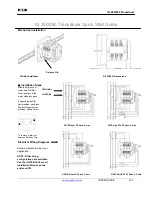
______________________________________________
HARRIS
888-9058-001
WARNING: Disconnect and lockout AC primary power prior to servicing
137
5.4.1 Introduction
Due to the complexity of the switch panel, the theory is broken up into the following operations:
•
Modes of Operation.
•
Button Presses
•
Button / Indicator Lighting
•
Error Messages and Indications.
The following definitions may be useful:
MAX 6954:
A Maxim LED/Key Matrix Controller. Used to control 128 LEDs and 32 switches.
Micro-controller:
The primary programmable device of the switch panel. It is a Freescale
MC9S12DP256 micro-controller.
Hardwired switches:
The hardwired switches are switches that are directly connected to the
transmitter’s controllers via connector J4 and ultimately, the parallel lines of the system bus.
They include the following 6 switches: On, Off, Power Raise, Power Lower, Remote Enable,
and Remote Disable, see Figure 6-15.
Hot buttons:
The lower six buttons on the front of the panel surrounded by a silk screen called
STATUS. These buttons indicate if a summery fault has occurred and in what function. Green is
Normal, Orange is Warning, and Red is Fault. The hot buttons include the following: Drive
Chain, Power Amp, Output, Power Supply, System, and Performance. By pressing these buttons,
the user can open the appropriate screen on the display, see Figure 6-15.
ISP:
In System Programming. The process used to update firmware/software on a board
without having to change physical components.
5.4.2 Modes of Operation
The switch panel has a dipswitch, under the back cover, which allows either of two modes of
operation to be selected.
•
In
Factory Test mode
, the switch panel will provide a means for lamp and
switch testing.
CAUTION:
This is not for customer use since the hardwired switches are still connected to the
transmitter’s controllers and will function normally.
5.4.2.1 Button Press Theory of Operation
There are 38 buttons on the switch panel: 12 on the front, 24 on the back, 1 on the pc
board and one under the metal cover. Six of the front buttons are hardwired directly to
the transmitter’s controllers via the 26-pin connector J4. They include Remote Enable,
Remote Disable, Power Lower, Power Raise, Transmitter On and OFF. This is done due
to the critical nature of these buttons. The other 32 buttons are programmable.
















































